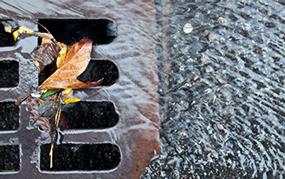Spend Less Energy Managing Water
 Communities and their residents use a lot of energy treating and moving drinking water and wastewater. They can significantly reduce municipal and domestic energy use by implementing green infrastructure practices that will:
Communities and their residents use a lot of energy treating and moving drinking water and wastewater. They can significantly reduce municipal and domestic energy use by implementing green infrastructure practices that will:
- reduce rainwater flows into sewer systems,
- recharge aquifers, and
- conserve water.
Cities, states, or regional entities should consider tying energy efficiency savings resulting from implementing these practices to reduced demand at power plants. EPA’s Office of Air and Radiation has developed the AVoided Emissions and ReGeneration Tool (AVERT) to assist with this task. AVERT uses local usage and grid data to estimate county-level emissions reductions at electric power plants from energy efficiency and renewable energy upgrades.
On this page:
This page contains technical information and references for state and local government officials working in the field of stormwater management.
How To
- Prioritize areas in your community to locate distributed green infrastructure practices for maximum rainwater storage and infiltration. If your community has combined sanitary and stormwater sewers, consider using hydrologic and hydraulic (H&H) modeling to identify ideal combinations of green and gray infrastructure within a given treatment area.
Learn more about using green infrastructure contributions to reduce combined sewer overflows in EPA’s Greening CSO Plans: Planning and Modeling Green Infrastructure for Combine Sewer Overflow (CSO) Control.
- While you are still in the planning process, you can estimate reduced pumping cost figures to help make the case for green infrastructure investments.
By using green infrastructure within their combined sewer area, Lancaster, Pennsylvania, has estimated that it will be able to reduce stormwater flows into its system by 700 million gallons, reaping over $600,000 in annual savings. A similar study by Milwaukee, Wisconsin, estimates future annual savings of $1.3 million due to reduced pumping and wastewater treatment.
Resources
AVoided Emissions and reGeneration Tool (AVERT)—EPA’s Office of Air and Radiation developed this tool to help estimate the emissions benefits of energy efficiency and renewable energy policies and programs.
Climate Ready Water Utilities (CRWU)—EPA’s CRWU initiative assists the water sector—including drinking water, wastewater, and stormwater utilities—in addressing climate change impacts. By developing practical and easy-to-use tools, practitioners can access clear climate science and adaptation options by translating complex climate projections into accessible formats.
Greening CSO Plans: Planning and Modeling Green Infrastructure for Combined Sewer Overflow—An EPA guide on modeling green infrastructure contributions to combined sewer overflow long-term control plans. Includes a case study on how to model reduction in total wastewater flows using dynamic H&H modeling.
Water Efficiency Saves Energy: Reducing Global Warming Pollution through Water Use Strategies (PDF)(4 pp, 763 K, About PDF) Exit—This National Resources Defense Council report outlines energy efficiency opportunities relating to water.
References
Spatari, S., Z. Yu, and F. A. Montalto. 2011. Life cycle implications of urban green infrastructure. PubMed.gov, U.S. National Library of Medicine National Institutes of Health. (6 pp, 410 K, About PDF) Exit.
De Sousa, M. R. C., F.A. Montalto, and S. Spatari. 2012. Using life cycle assessment to evaluate green and grey combined sewer overflow control strategies. Journal of Industrial Ecology 16:901–913. doi: 10.1111/j.1530-9290.2012.00534.x.
U.S. EPA. 2014. The Economic Benefits of Green Infrastructure: A Case Study of Lancaster, PA.
Milwaukee Metropolitan Sewerage District. Green Infrastructure Benefits and Costs: MMSD Regional Green Infrastructure Plan. Online Resource. (14 pp, 1MB)
